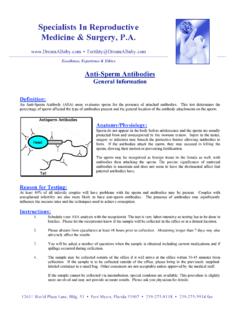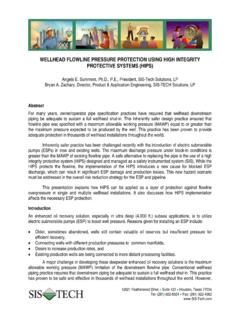Transcription of Specialists In Reproductive Medicine & Surgery, P.A.
1 Specialists In Reproductive Medicine & surgery , Excellence, Experience & Ethics 12611 World Plaza Lane, Bldg. 53 Fort Myers, Florida 33907 239-275-8118 239-275-5914 fax Saline Infusion Sonography (SIS) Patient Information Definition: Because the inside walls of the uterus normally are pressed against each other, ultrasound often cannot accurately determine if irregularities of the inner uterine wall are present. With the Saline Infusion Sonography (SIS) procedure, warmed sterile saline is slowly passed into the uterine cavity using a small soft plastic tube. The infused saline separates the walls of the uterus and improves the chances that abnormalities within the uterine cavity are detected. Combined with the general pelvic ultrasound imaging, the entire pelvis ( , uterus, ovaries and nearby structures) is well visualized. Indications: Frequent indications for SIS include abnormal uterine bleeding, a previously abnormal hysterosalpingogram (HSG) or suspected uterine fibroids, intrauterine adhesions or endometrial polyps.
2 For many patients, it is important to determine that the pelvis and uterine cavity are normal before initiating conception. Some believe the procedure is accurate up to 95% (19 out of 20) of the time in finding abnormalities, if any exists. Therefore, there is only a small possibility that an existing problem will be missed when performing the SIS procedure. Scheduling: The SIS is usually done between days 5-9 of your menstrual cycle. We ask that you call the office on the first business day closest to the first day of your menses. The timing of the SIS is done so as to minimize the amount of menstrual blood present, improve the visualization and minimize the possibility of disrupting an unexpected early pregnancy. This procedure is only diagnostic, so any abnormalities that are found are generally treated at a later date. What the Test Can and Can Not Diagnose: The test is able to diagnose such abnormalities as uterine polyps, fibroids, intra-uterine adhesions and general malformations of uterine shape and size.
3 The study can also help to indirectly diagnose blocked fallopian tubes. If there is minimal fluid in the pelvis before the SIS procedure and following the procedure fluid has collected in the pelvic cavity, the fluid must have had to pass from the uterus through at least one open Fallopian tube. The test is generally unable to diagnose such problems as endometriosis and hormone abnormalities. Saline Infusion Sonography Patient Information (cont.) Page 2 of 4 It is possible that the test will indicate an abnormality when one is not actually present (described as an artifact or a false-positive finding) but most believe this will occur in less than 5% (1 in 20) of the patients. General Instructions: While not absolutely necessary, we encourage your partner to be present in the room during the procedure. If you are having significant pelvic pain on the day of the procedure, please contact the office because the procedure may need to be rescheduled.
4 Antibiotics are not generally given before the procedure unless otherwise indicated ( , mitral valve prolapse). The infection rate is so low after the procedure, routine antibiotics will often sicken more patients then they will help. You will be asked to sign a consent that states that you have read these materials and have had your questions answered in a satisfactory fashion. Your clinician will be happy to discuss any of your concerns prior to your signing the consent. We suggest that you take about 600-800 mg. of Ibuprofen about 1-2 hours prior to the procedure. Other medications may be prescribed or given to you near the time of the procedure. The entire procedure takes about 20 minutes. The Procedure Will Take Place As Follows; 1. You will be asked to undress from the waist down. 2. If your pelvis is unusually tender, your health care provider may perform a pelvic exam. If the exam is abnormal, your procedure may be canceled.
5 3. A transvaginal ultrasound will be performed to evaluate the pelvic contents before instilling any fluid into the uterine cavity. 4. A speculum will then be placed and the cervix swabbed with a cleansing solution. 5. Depending upon the size of the cervical opening, a slender flexible catheter will be gently inserted though the cervix and into the uterine cavity. Rarely, local anesthesia followed by endocervical dilation may be necessary prior to the actual placement of the catheter. The cervix may also need to be gently grasped in order to perform the procedure, but this is quite uncommon. 6. The speculum will be removed and the vaginal ultrasound replaced. The actual instillation of fluid into the uterine cavity will be initiated. As the uterus fills with the warmed saline, you may feel some pelvic fullness and cramping, cramps commonly compared to stronger menstrual cramps. 7. All materials will be removed and you will be allowed to rest as long as necessary following the procedure.
6 You may then go on to your normal level of activity. Complications: Menstrual-like cramps, slight vaginal bleeding are common complaints. Following the procedure, you may be slightly dizzy, which goes away with rest. Severe complications are very infrequent. Uterine perforation is a possible although an infrequent complication of this particular procedure. The uterus is a rather hearty organ and has holes placed into it frequently without difficulty such as what occurs with amniocenteses. It is nearly impossible to perforate the uterus with the soft flexible catheters that are used in the SIS procedure. Saline Infusion Sonography Patient Information (cont.) Page 3 of 4 You may have an allergic reaction to any medicines given to you prior to or during the procedure. These are infrequent and generally resolve quite rapidly. There is the possibility that an early pregnancy could be present when the test is done.
7 While extremely unlikely, it is uncertain what the effects would be to the developing pregnancy. If there is a concern, a pregnancy test may be requested. We attempt to minimize the estimated post-procedure 1% infection rate by checking, when necessary, cervical cultures and perhaps by performing a pelvic exam just prior to the procedure. If an infection does occur, oral or IV antibiotics and hospitalization will be needed. Rarely, as with any pelvic infection, hospital admission and/or surgery to remove infected organs may be necessary leading to sterility. Individuals who become infected were most likely previously infected and almost always have underlying severe tubal disease. The procedure rarely initiates a new infection, but rather, re a ct iv at esre a ct iv at es an underlying infection. Interpretation: If time allows, your clinician may discuss the results with you directly after the procedure.
8 It should be understood that many managed care organizations do not allow for procedures and follow-up discussions to be done on the same day, so separate visits are generally scheduled. Post-SIS Instructions: Activity: The type and amount of activity tolerated after the procedure will vary from person to person. In general, there are minimal effects from the SIS procedure and activity need not be modified. Vaginal Discharge: A slight amount of vaginal discharge or bleeding may be present. Bleeding heavier than a normal period is not normal and you should contact the office. Please do not douche following the procedure. The cervix may be more open allowing material to be flushed in the uterus and tubes resulting in a pelvic infection. Sexual Intercourse: Vaginal intercourse may take place 24-48 hours following the procedure, unless the clinician has instructed you otherwise. Discomfort: You may take Motrin, Advil or Tylenol following the SIS for the minimal pelvic discomfort.
9 Please contact the office if there is an increase in abdominal pain not controlled by these medications. When to Call: Fever of over F, pain that does not improve with time or medication, heavy vaginal bleeding are all good reasons to call the office. This information sheet may not answer all of your particular questions so contact the office when other concerns arise. For informational calls, the nursing staff will generally call you back within 48 hours. Updated 01/22/2009 K:\Docs\Forms\Saline Infusion Sonography (SIS) Patient Copyright 2003, Specialists In Reproductive Medicine & surgery , , Saline Infusion Sonography Patient Information (cont.) Page 4 of 4 E-mail: Web Site.














![[Logo To Come] - Lazard](/cache/preview/b/e/f/6/9/1/8/9/thumb-bef691898073c3588972f362b9ac0cd8.jpg)
